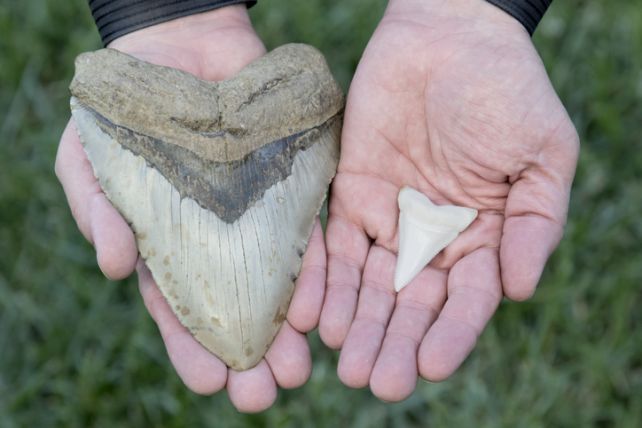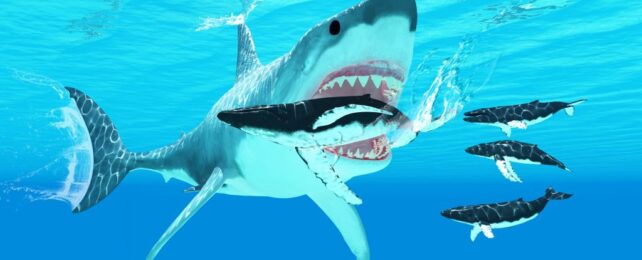Megalodon, the terror of the Neogene, dominated its giant shark niche for just 20 million years before it disappeared from the world's oceans.
And, during that time, it hunted anything and everything that crossed its path. It didn't distinguish: if it was large enough to be a snack, megalodon (Odotus megalodon) partook.
Scientists have reached that conclusion after studying the teeth of modern sharks, and comparing them to the fossilized teeth of megalodon, almost all we have left of the extinct fish today.
This contradicts the theory that the main prey of megalodon was whales. Certainly megalodon could and did eat whales – but its diet as a whole was far more opportunistic.
"Our study tends rather to draw a picture of megalodon as an ecologically versatile generalist," says geoscientist Jeremy McCormack of Goethe University Frankfurt in Germany. "Megalodon was by all means flexible enough to feed on marine mammals and large fish, from the top of the food pyramid as well as lower levels – depending on availability."

Megalodon is an extinct species of shark that lived from around 23 million to around 3.6 million years ago, during which time it occupied a prime position at the top of the food web, before being driven to extinction. We will never know for certain what it looked like; like all sharks, its skeleton was mostly cartilage, and all it left behind was a lot of teeth and a few vertebrae.
We know from these remains, however, that megalodon was enormous, with size estimates ranging from around 11 meters to over 40 meters (36 to 131 feet) in length (although the latter is an outlier, and most estimates hover around 13 to 20 meters). That's huge – so huge that scientists think that megalodon may have specialized in large prey.
One way to determine the diet of someone who has been dead a long time is to look at isotopes in their teeth. An isotope of an element is an atom that deviates from the norm in the number of neutrons it has in its nucleus, and the ratios of these isotopes vary according to several factors, one of which is diet.

This is because when we eat, some of the metals in our food replace some of the calcium in our teeth and bones – not so you notice, obviously, but enough to leave a tracer. McCormack and his colleagues looked specifically at the ratios of two isotopes of zinc – the lighter zinc-64 and the heavier zinc-66.
When fish at the bottom of the food web eat, they store less zinc-66 than zinc-64. The fish that eat those fish have even less zinc-66. So when you get to the fish at the very top of the chain, you see the very least zinc-66 compared to zinc-64. This is what the researchers observed in the teeth of megalodon and its cousin, the extinct Odotus chubutensis.
The researchers don't really know what was at the bottom of the food chain 18 million years ago, the time from which the megalodon teeth they studied hailed. So, they compared the megalodon teeth with the teeth of sharks that swim the oceans today to work out what the giant predators ate.
"Sea bream, which fed on mussels, snails, and crustaceans, formed the lowest level of the food chain we studied," McCormack says.
"Smaller shark species such as requiem sharks and ancestors of today's cetaceans, dolphins, and whales, were next. Larger sharks such as sand tiger sharks were further up the food pyramid, and at the top were giant sharks like Araloselachus cuspidatus and the Otodus sharks, which include megalodon."

Megalodon's status as a superpredator at the very top of the food web has been established previously. The new research reveals that the isotope difference between megalodon and the animals at the lowest level the researchers studied was not a sharp delineation, suggesting that the shark was not a fussy eater.
There were also intriguing differences in megalodon diet depending on where the animals lived. Megalodon teeth found in Passau, Germany, dined more heavily on the lower levels of the food web, the researchers found.
This is not dissimilar to the opportunistic hunting approach demonstrated by white sharks (Carcharias carcharodon), which stands to reason: previous work led by McCormack showed that the rise of the white shark was likely one of the drivers that led megalodon to extinction. With competition in its ecological niche, megalodon became more vulnerable.
"It gives us important insights into how the marine communities have changed over geologic time," says paleobiologist Kenshu Shimada of DePaul University in the US, "but more importantly the fact that even 'supercarnivores' are not immune to extinction."
The research has been published in Earth and Planetary Science Letters.
